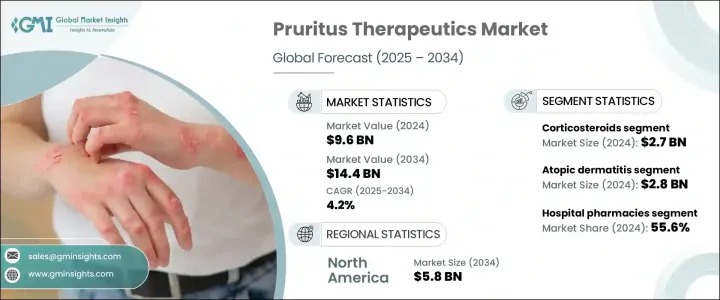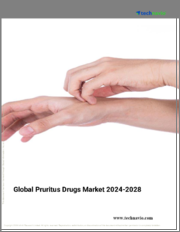
|
시장보고서
상품코드
1708133
세계의 소양증 치료제 시장 기회, 성장 촉진요인, 산업 동향 분석 및 예측(2025-2034년)Pruritus Therapeutics Market Opportunity, Growth Drivers, Industry Trend Analysis, and Forecast 2025 - 2034 |
||||||
세계 소양증 치료제 시장은 2024년 96억 달러에 달했고, 2025-2034년 연평균 4.2%의 성장률을 보일 것으로 예측됩니다.
아토피 피부염, 건선, 만성 신장 질환 등으로 인한 만성 가려움증 질환의 발생률 증가가 시장 확대의 원동력이 되고 있습니다. 가려움증은 흔하지만 치료가 쉽지 않은 질환이기 때문에 첨단 치료 솔루션에 대한 수요가 가속화되고 있습니다. 전 세계적으로 피부 및 전신 질환에 대한 치료 부담이 증가함에 따라 제약사들은 치료 포트폴리오를 혁신하고 확장해야 할 필요성이 대두되고 있습니다. 만성 소양증에 취약한 노년층 인구 증가는 시장 수요를 더욱 증가시키고 있습니다. 또한, 사용 가능한 치료법에 대한 인식이 높아지고 의료 서비스 접근성이 개선되면서 향후 10년간 지속적인 성장 동력이 될 것으로 예측됩니다.

의학 연구의 발전은 생물학적 제제 및 JAK 억제제와 같은 새로운 약물이 유망한 결과를 가져오는 등 소양증 치료제의 전망을 크게 바꾸고 있습니다. 이러한 혁신적인 치료법은 단순히 증상을 완화하는 것뿐만 아니라 근본적인 원인을 해결함으로써 시장을 재편하고 있습니다. 제약사들은 연구개발에 적극적으로 투자하여 부작용을 최소화하고 장기적인 완화를 가져올 수 있는 표적 치료법을 도입하려고 노력하고 있습니다. 정밀의료의 부상과 소양증 관련 질환에 대한 임상시험의 확대는 업계 기업들에게 새로운 비즈니스 기회를 제공합니다. 환자 중심의 치료가 강조되면서, 각 업체들은 보다 효과적이고 안전하며 개인화된 치료법 개발에 집중하고 있습니다.
| 시장 범위 | |
|---|---|
| 시작 연도 | 2024년 |
| 예측 연도 | 2025-2034년 |
| 시작 금액 | 96억 달러 |
| 예상 금액 | 144억 달러 |
| CAGR | 4.2% |
아토피 피부염 분야는 2024년 세계 시장 점유율 35.7%를 차지했으며, 높은 유병률과 표적 치료의 시급한 필요성에 의해 주도되고 있습니다. 아토피 피부염에 수반되는 만성 가려움증은 삶의 질에 큰 영향을 미치기 때문에 환자와 의료진은 보다 효과적인 해결책을 찾고 있습니다. 비스테로이드성 치료제와 생물학적 제제를 포함한 새로운 치료제의 개발은 치료 선택의 폭을 넓히는 데 기여하고 있습니다. 한편, 간 질환과 연관된 담즙성 소양증은 효과적인 치료제에 대한 수요를 더욱 증가시키고 있습니다. 소양증 시장은 계속 진화하고 있으며, 새로운 치료 적응증과 첨단 치료제에 대한 접근성 확대가 큰 성장의 원동력이 되고 있습니다.
부신피질 스테로이드는 여전히 소양증 치료제의 주요 제품군으로 큰 시장 점유율을 차지하고 있습니다. 부신피질 스테로이드의 2024년 시장 규모는 40억 달러에 달했으며, 다양한 소양증에 대한 핵심 치료제로서의 역할을 확고히 하고 있습니다. 부신피질 스테로이드는 피부염, 두드러기 등의 증상에 널리 사용되고 있으며, 그 효능이 널리 알려져 있습니다. 바르는 크림, 먹는 약, 주사제 등 다양한 제형으로 출시되어 환자의 다양한 요구를 충족시킬 수 있습니다. 특히 비용 효율적인 치료 옵션이 필수적인 지역에서는 저렴한 가격과 접근성 덕분에 보급이 더욱 확대되고 있습니다.
미국 소양증 치료제 시장의 2024년 시장 규모는 36억 달러로, 만성 소양증의 높은 유병률과 의료 시스템의 확립으로 인해 우위를 유지하고 있습니다. 강력한 R&D 이니셔티브와 혁신적인 치료제의 꾸준한 파이프라인이 시장 성장을 지속적으로 견인하고 있습니다. 생물학적 제제, JAK 억제제, 표적 치료제의 확대로 치료 성적이 개선되고 있으며, 개인 맞춤형 의료의 부상으로 환자 치료의 형태가 변화하고 있습니다. 소양증의 근본적인 원인에 대한 관심이 높아짐에 따라 미국 시장은 앞으로도 기술 혁신과 접근성 향상을 주도하며 치료 발전의 최전선에 서게 될 것으로 예측됩니다.
목차
제1장 조사 방법과 조사 범위
제2장 주요 요약
제3장 업계 인사이트
- 생태계 분석
- 업계에 대한 영향요인
- 성장 촉진요인
- 업계의 잠재적 리스크&과제
- 성장 가능성 분석
- 규제 상황
- 파이프라인 분석
- 향후 시장 동향
- Porter's Five Forces 분석
- PESTEL 분석
제4장 경쟁 구도
- 서론
- 기업 점유율 분석
- 기업 매트릭스 분석
- 주요 시장 기업 - 경쟁 분석
- 경쟁 포지셔닝 매트릭스
- 전략 대시보드
제5장 시장 추산 및 예측 : 제품별, 2021년-2034년
- 주요 동향
- 부신피질 스테로이드제
- 항히스타민제
- 항자극제
- 면역억제제
- 칼시뉴린 억제제
- 기타 제품
제6장 시장 추산 및 예측 : 용도별, 2021년-2034년
- 주요 동향
- 아토피 피부염
- 알레르기성 접촉 피부염
- 건선
- 두드러기
- 기타 용도
제7장 시장 추산 및 예측 : 유통 채널별, 2021년-2034년
- 주요 동향
- 병원 약국
- 소매 약국
- 온라인 약국
제8장 시장 추산 및 예측 : 지역별, 2021년-2034년
- 주요 동향
- 북미
- 미국
- 캐나다
- 유럽
- 독일
- 영국
- 프랑스
- 스페인
- 이탈리아
- 네덜란드
- 아시아태평양
- 중국
- 일본
- 인도
- 호주
- 한국
- 라틴아메리카
- 브라질
- 멕시코
- 아르헨티나
- 중동 및 아프리카
- 남아프리카공화국
- 사우디아라비아
- 아랍에미리트(UAE)
제9장 기업 개요
- AbbVie
- Amgen
- Astellas Pharma
- Arcutis Biotherapeutics
- Bristol-Myers Squibb
- Cara Therapeutics
- Eli Lilly And Company
- GSK
- Galderma
- Johnson &Johnson
- Kyowa Kirin
- Novartis AG
- Pfizer
- Sanofi
- Teva Pharmaceutical Industries
The Global Pruritus Therapeutics Market reached USD 9.6 billion in 2024 and is projected to grow at a CAGR of 4.2% between 2025 and 2034. The rising incidence of chronic itching disorders, driven by conditions such as atopic dermatitis, psoriasis, and chronic kidney disease, continues to fuel market expansion. As pruritus remains a common yet often challenging symptom to treat, the demand for advanced therapeutic solutions is accelerating. The increasing burden of dermatologic and systemic conditions worldwide is compelling pharmaceutical companies to innovate and expand their treatment portfolios. The growing geriatric population, a demographic highly susceptible to chronic pruritus, further amplifies market demand. Additionally, heightened awareness regarding available treatments, coupled with improved access to healthcare services, is expected to drive sustained growth over the next decade.

Advancements in medical research are transforming the pruritus therapeutics landscape, with new drug classes such as biologics and JAK inhibitors offering promising results. These innovative treatments are reshaping the market by addressing underlying causes rather than just alleviating symptoms. Pharmaceutical firms are actively investing in research and development to introduce targeted therapies that provide long-term relief with minimal side effects. The rise of precision medicine and the expansion of clinical trials for pruritus-related conditions are creating new opportunities for industry players. With a growing emphasis on patient-centric care, companies are focusing on developing more effective, safer, and personalized treatment options.
| Market Scope | |
|---|---|
| Start Year | 2024 |
| Forecast Year | 2025-2034 |
| Start Value | $9.6 Billion |
| Forecast Value | $14.4 Billion |
| CAGR | 4.2% |
The atopic dermatitis segment accounted for 35.7% of the global market share in 2024, driven by its high prevalence and the urgent need for targeted therapies. Chronic itching associated with atopic dermatitis significantly impacts quality of life, pushing patients and healthcare providers to seek more effective solutions. The development of novel medications, including non-steroidal treatments and biologic therapies, has been instrumental in expanding treatment options. Meanwhile, cholestatic pruritus, often linked to liver diseases, has further intensified the demand for effective therapeutics. The pruritus market continues to evolve, with new treatment indications and expanded access to advanced medications driving substantial growth.
Corticosteroids remain the leading product category in pruritus therapeutics, accounting for a significant market share. The corticosteroids segment was valued at USD 4 billion in 2024, cementing its role as a cornerstone treatment for various pruritic conditions. Widely recognized for their efficacy, corticosteroids are commonly used for conditions such as dermatitis and urticaria. Their availability in multiple formulations-including topical creams, oral medications, and injectables-ensures their adaptability for different patient needs. Their affordability and accessibility further reinforce their widespread use, particularly in regions where cost-effective treatment options are essential.
The U.S. Pruritus Therapeutics Market was valued at USD 3.6 billion in 2024, maintaining its dominance due to a high prevalence of chronic pruritus conditions and a well-established healthcare system. Strong research and development initiatives, coupled with a steady pipeline of innovative treatments, continue to propel market growth. The expansion of biologics, JAK inhibitors, and targeted therapies is enhancing treatment outcomes, while the rise of personalized medicine is reshaping patient care. With a growing focus on addressing the root causes of pruritus, the U.S. market is expected to remain at the forefront of therapeutic advancements, driving innovation and accessibility in the years to come.
Table of Contents
Chapter 1 Methodology and Scope
- 1.1 Market scope and definitions
- 1.2 Research design
- 1.2.1 Research approach
- 1.2.2 Data collection methods
- 1.3 Base estimates and calculations
- 1.3.1 Base year calculation
- 1.3.2 Key trends for market estimation
- 1.4 Forecast model
- 1.5 Primary research and validation
- 1.5.1 Primary sources
- 1.5.2 Data mining sources
Chapter 2 Executive Summary
- 2.1 Industry 360° synopsis
Chapter 3 Industry Insights
- 3.1 Industry ecosystem analysis
- 3.2 Industry impact forces
- 3.2.1 Growth drivers
- 3.2.1.1 Rising prevalence of dermatological diseases
- 3.2.1.2 Advancements in targeted therapies and biologics
- 3.2.1.3 Increasing awareness and diagnosis rates
- 3.2.1.4 Growing geriatric population
- 3.2.2 Industry pitfalls and challenges
- 3.2.2.1 High cost of biologic and targeted therapies
- 3.2.2.2 Side effects and safety concerns
- 3.2.1 Growth drivers
- 3.3 Growth potential analysis
- 3.4 Regulatory landscape
- 3.5 Pipeline analysis
- 3.6 Future market trends
- 3.7 Porter's analysis
- 3.8 PESTEL analysis
Chapter 4 Competitive Landscape, 2024
- 4.1 Introduction
- 4.2 Company market share analysis
- 4.3 Company matrix analysis
- 4.4 Competitive analysis of major market players
- 4.5 Competitive positioning matrix
- 4.6 Strategy dashboard
Chapter 5 Market Estimates and Forecast, By Product, 2021 – 2034 ($ Mn)
- 5.1 Key trends
- 5.2 Corticosteroids
- 5.3 Antihistamines
- 5.4 Counterirritants
- 5.5 Immunosuppressant
- 5.6 Calcineurin inhibitors
- 5.7 Other products
Chapter 6 Market Estimates and Forecast, By Application, 2021 – 2034 ($ Mn)
- 6.1 Key trends
- 6.2 Atopic dermatitis
- 6.3 Allergic contact dermatitis
- 6.4 Psoriasis
- 6.5 Urticaria
- 6.6 Other applications
Chapter 7 Market Estimates and Forecast, By Distribution Channel, 2021 – 2034 ($ Mn)
- 7.1 Key trends
- 7.2 Hospital pharmacies
- 7.3 Retail pharmacies
- 7.4 Online pharmacies
Chapter 8 Market Estimates and Forecast, By Region, 2021 – 2034 ($ Mn)
- 8.1 Key trends
- 8.2 North America
- 8.2.1 U.S.
- 8.2.2 Canada
- 8.3 Europe
- 8.3.1 Germany
- 8.3.2 UK
- 8.3.3 France
- 8.3.4 Spain
- 8.3.5 Italy
- 8.3.6 Netherlands
- 8.4 Asia Pacific
- 8.4.1 China
- 8.4.2 Japan
- 8.4.3 India
- 8.4.4 Australia
- 8.4.5 South Korea
- 8.5 Latin America
- 8.5.1 Brazil
- 8.5.2 Mexico
- 8.5.3 Argentina
- 8.6 Middle East and Africa
- 8.6.1 South Africa
- 8.6.2 Saudi Arabia
- 8.6.3 UAE
Chapter 9 Company Profiles
- 9.1 AbbVie
- 9.2 Amgen
- 9.3 Astellas Pharma
- 9.4 Arcutis Biotherapeutics
- 9.5 Bristol-Myers Squibb
- 9.6 Cara Therapeutics
- 9.7 Eli Lilly And Company
- 9.8 GSK
- 9.9 Galderma
- 9.10 Johnson & Johnson
- 9.11 Kyowa Kirin
- 9.12 Novartis AG
- 9.13 Pfizer
- 9.14 Sanofi
- 9.15 Teva Pharmaceutical Industries



















